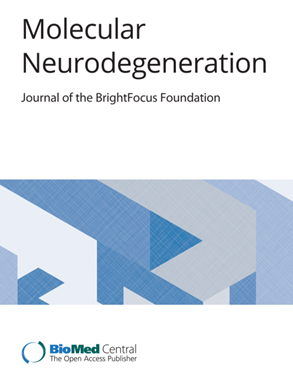一个免疫细胞绑定所有免疫细胞:血小板对神经退行性疾病的贡献
IF 17.5
1区 医学
Q1 NEUROSCIENCES
引用次数: 0
摘要
阿尔茨海默病(AD)和相关痴呆症(ADRD)共同影响着全球很大一部分老龄人口。阿尔茨海默病的病理发展不仅包括淀粉样β(Aβ)斑块堆积和神经纤维缠结发展等经典特征,还包括血管和慢性炎症过程的影响。最近,血小板已成为全身性炎症和神经炎症的核心参与者。研究表明,血小板受体表达发生改变的患者会表现出认知能力加速衰退,而不受传统风险因素的影响。此外,与对照组相比,注意力缺失症患者的血小板表现出更强的非刺激性激活。血小板颗粒中含有与阿氏症相关的重要蛋白,如 tau 和淀粉样前体蛋白 (APP)。血小板外泌失调会导致以出血、中风和认知能力下降风险增加为特征的疾病表型。最近的研究表明,这些影响与血液循环中血小板的数量无关。这突显了一个假设,即血小板介导的炎症和愈合过程的紊乱可能在 ADRD 的发展中起着至关重要的作用。全面研究血小板,包括其受体、分泌分子以及在 AD 和 ADRD 循环系统中与其他细胞的炎症相互作用中的各种作用,将为疾病管理和干预带来光明前景。本综述将讨论血小板在 ADRD 中的关键作用。本文章由计算机程序翻译,如有差异,请以英文原文为准。
One immune cell to bind them all: platelet contribution to neurodegenerative disease
Alzheimer’s disease (AD) and related dementias (ADRD) collectively affect a significant portion of the aging population worldwide. The pathological progression of AD involves not only the classical hallmarks of amyloid beta (Aβ) plaque buildup and neurofibrillary tangle development but also the effects of vasculature and chronic inflammatory processes. Recently, platelets have emerged as central players in systemic and neuroinflammation. Studies have shown that patients with altered platelet receptor expression exhibit accelerated cognitive decline independent of traditional risk factors. Additionally, platelets from AD patients exhibit heightened unstimulated activation compared to control groups. Platelet granules contain crucial AD-related proteins like tau and amyloid precursor protein (APP). Dysregulation of platelet exocytosis contributes to disease phenotypes characterized by increased bleeding, stroke, and cognitive decline risk. Recent studies have indicated that these effects are not associated with the quantity of platelets present in circulation. This underscores the hypothesis that disruptions in platelet-mediated inflammation and healing processes may play a crucial role in the development of ADRD. A thorough look at platelets, encompassing their receptors, secreted molecules, and diverse roles in inflammatory interactions with other cells in the circulatory system in AD and ADRD, holds promising prospects for disease management and intervention. This review discusses the pivotal roles of platelets in ADRD.
求助全文
通过发布文献求助,成功后即可免费获取论文全文。
去求助
来源期刊

Molecular Neurodegeneration
医学-神经科学
CiteScore
23.00
自引率
4.60%
发文量
78
审稿时长
6-12 weeks
期刊介绍:
Molecular Neurodegeneration, an open-access, peer-reviewed journal, comprehensively covers neurodegeneration research at the molecular and cellular levels.
Neurodegenerative diseases, such as Alzheimer's, Parkinson's, Huntington's, and prion diseases, fall under its purview. These disorders, often linked to advanced aging and characterized by varying degrees of dementia, pose a significant public health concern with the growing aging population. Recent strides in understanding the molecular and cellular mechanisms of these neurodegenerative disorders offer valuable insights into their pathogenesis.
 求助内容:
求助内容: 应助结果提醒方式:
应助结果提醒方式:


